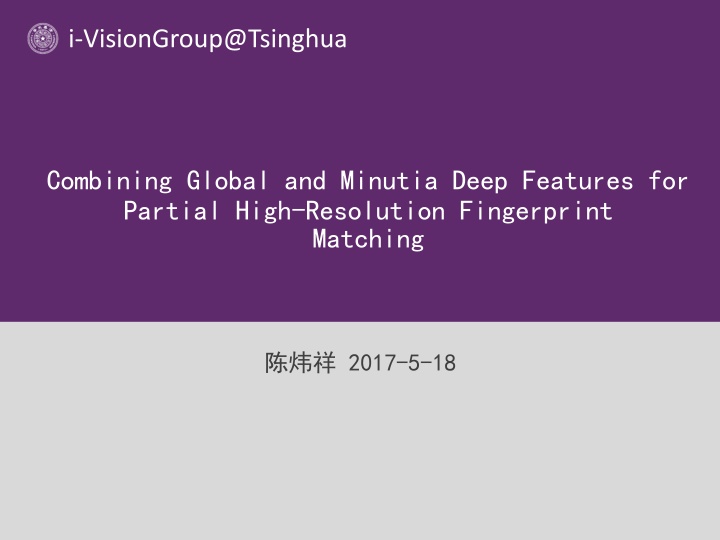
Partial High-Resolution Fingerprint Matching Research
"Explore the innovative approach of combining global and minutia deep features for enhanced partial high-resolution fingerprint matching. This study introduces a deep CNN-based model for feature embedding and proposes a fusion scheme for effective matching. Dive into the world of advanced fingerprint recognition technology."
Download Presentation

Please find below an Image/Link to download the presentation.
The content on the website is provided AS IS for your information and personal use only. It may not be sold, licensed, or shared on other websites without obtaining consent from the author. If you encounter any issues during the download, it is possible that the publisher has removed the file from their server.
You are allowed to download the files provided on this website for personal or commercial use, subject to the condition that they are used lawfully. All files are the property of their respective owners.
The content on the website is provided AS IS for your information and personal use only. It may not be sold, licensed, or shared on other websites without obtaining consent from the author.
E N D
Presentation Transcript
i-VisionGroup@Tsinghua Combining Global and Minutia Deep Features for Partial High-Resolution Fingerprint Matching 2017-5-18 i-VisionGroup@Tsinghua
Combining Global and Minutia Deep Features for Partial High-Resolution Fingerprint. Fandong Zhanga, Shiyuan Xina, Jufu Fenga,PR-Letter Mobile the fingerprint sensors are miniaturized partial fingerprints Minutiea based feature no more than 20 minutieas Their accuracy degrades significantly Texture based feature not designed to make full use of fingerprint structures 3-level Feature Optical sensor 200dpi VS capacitive sensor 500dpi 3-level feature make up for the insufficiency of minutiae combine both global and local deep features. triplet-based training. 2 i-VisionGroup@Tsinghua
: FMR10000 13.11% FMR100000 18.06% ZeroFMR 19.72% Contribution employ a deep CNN to learn global features present a method to learn deep features of minutiae propose a combined matching scheme with score level fusion of global similarity and spectral correspondence based score of minutia matching. 3 i-VisionGroup@Tsinghua
Deep Global Feature Embedding a CNN based on ResNet. 1. Triplet Loss a triplet < ?? we want to ensure that anchor is closer to positive than negative in feature space. ?,?? ?is positive and ?? ?,?? ?>,?? ?is anchor. ?? ?is negative. 2 ? ?max{0, ? ? ?? ? loss function: ????????= ? 2+ } ? ?? ? ?? ? ? ?? 4 2. KNN-Triplet Selection Generate the training triplet set. i-VisionGroup@Tsinghua
? fingerprints per identity. ? identities and ?? ? negative fingerprint. sample ?? Randomly get ?? For an anchor, select ??nearest positives as ?? So ?? knn L2 ?. ? ??triplet got in one mini-batch. ? ?? 5 i-VisionGroup@Tsinghua
3.Joint Feature Learning triplet convergence slow. 1) Gradients of different batches may conflict to each other. ???? ? ?? ???? ????????? ?????. 2) ? ?? Softmax loss doesn t have the above problems. ? = ????????+ ? ??????? 6 i-VisionGroup@Tsinghua
Deep Minutiae Feature Embedding detect minutiae rotate to zero degree input to network Label? 1. Generating Minutiae Labels Minutiae Detection: Pairwise Fingerprint Matching Association Graph Establishing Minutiae Labels Generation label 2. Deep Feature Learning only use triplet loss as objective function and design a specific triplet selection policy 7 i-VisionGroup@Tsinghua
Combined Matching Scheme 1. Global Matching Use Cosine distance 2. Minutiae-based Matching Use Cosine distance of deep feature. Choose the bi-directional best matches as candidates ????? represents all matched minutiae pairs after spectral correspondence. ?is total compatibility of ????? ?is total similarity of ????? ?? all matched minutiae in ?? ?represents minutiae within the convex hull formed by 8 i-VisionGroup@Tsinghua
3. Matching Fusion Experiments optical fingerprint sensor with area 0.24 0.39 . T:20 scans on different finger regions were enrolled as templates for each finger. Q:40 scans with varying finger regions and orientations as verification images. Totally 1800 identities,180 for testing and remaining 1620 for training. 9 i-VisionGroup@Tsinghua
Variant 1 (denoted as Global): Only using global feature for matching. Variant 2 (denoted as Global-K): Same as Global but removing KNN triplet- selection policy. Variant 3 (denoted as Global-T): Same as Global but removing triplet loss. Variant 4 (denoted as Global-S): Same as Global but removing softmax loss. Variant 5 (denoted as Minutia): Only using minutia feature for matching. minutiae-based algorithm AKAZE-based algorithm 10 i-VisionGroup@Tsinghua
11 i-VisionGroup@Tsinghua
12 i-VisionGroup@Tsinghua
